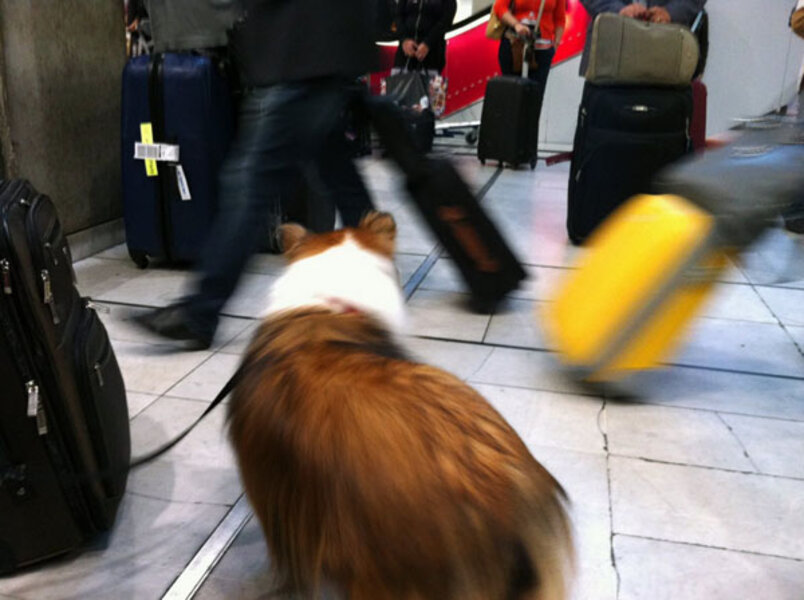Thanksgiving travel fun? Take the dog ... or cat or bird
| LOS ANGELES
Travel for humans during holidays is tough enough: Long lines, crowds everywhere, extra bags full of presents. Throw a pet in the mix, and it's a recipe for disaster.
But Sheron Long, a frequent traveler and author of "Dog Trots Globe — To Paris and Provence," says it's worth the trouble.
RELATED: Travel with toddlers – 6 tips for avoiding airplane meltdowns
"Every trip was better when Chula could be with us," she said of her Shetland sheepdog. "She was so excited, I could imagine her dog's eye view of the world. It causes you to explore and go see different things and meet people."
The US Department of Transportation estimates more than 2 million pets and other animals are transported by air each year in America. Pets aren't allowed on Amtrak trains, Greyhound buses or cruise lines, but they can go on many regional train, bus, and boat lines.
The majority of four-legged carry-on passengers are dogs, but some airlines allow rabbits, birds, and other small animals. Experts say before including a pet in travel plans, consider whether it would enjoy the experience.
"Some dogs don't like to travel, some love it," said Kelly E. Carter, the pet travel expert for AOL's Paw Nation and a Chihuahua owner. "You have to know your pet."
Caroline Golon's two Persian cats "are not big fans of car travel" – the only way they can travel since their breed is banned by many airlines — so they don't go on trips. Ms. Golon said when they travel, the family stops at pet-friendly hotels rather than drive nonstop.
"Stopping overnight gives them a chance to use the litter box at their leisure and eat and drink comfortably," said Golon, the founder of High Paw Media.
Gwen Cooper, the author of "Homer's Odyssey: A Fearless Feline Tale, or How I Learned About Love and Life with a Blind Wonder Cat," said animals pick up on their owners' moods, "which means if you're nervous, your cat or dog is going to be nervous too. The best way to avoid being nervous is to prepare you and your pet ahead of time and think through as many contingencies as possible."
For eligible cats, as well as dogs, airlines have size requirements for pets in the cabin, so a small pet must fit in a carrier that can be stowed under a seat and larger ones must be checked in. Ms. Long's dog weighs 30 pounds, (13 1/2 kilograms) so 9-year-old Chula has to fly in cargo.
During the holidays, though, when planes are fuller and lines are longer, some airlines ban pets in cargo, as well as times when the heat or cold is intense. Certain breeds can never fly on some airlines, including those considered to have bullying characteristics, like pit bulls, and snub-nosed animals like Shih Tzus or Persian cats because of potential breathing problems.
Animals that travel on Amtrak, Greyhound or cruises get a ticket to ride through their roles as service animals. Under the Americans with Disabilities Act, trained helper animals such as guide dogs or signal dogs must be allowed.
Pet accommodations at airports differ, though every airport has animal-relief areas. Some are easy to find — San Francisco's has paw prints on the floor leading to them — and most or all areas are located outside of security checkpoints. Federal transportation guidelines require animals to be removed from carriers, so pets should be collared and leashed — especially cats. Pet carriers are not X-rayed, but owners' hands may be wiped for chemical testing.
The hassle of traveling is only half over once the plane lands. Carter, who once canceled a trip in which she and her dog were hoping to try a new hotel in Northern California, recounted how the hotel worded its pet policy online: "We are smoke-free and pet-free."
"[A]re pets being considered killers, like smoke? That's a sign people don't want to be around pets," she said.
Lisa Porter, CEO of a website that lists pet-friendly places to stay and activities around the country, said more businesses are catering to customers with a pet in tow than ever before. For example, vineyards and wineries have opened their tours to pets, and as many as 90 percent of hotels in some cities are pet-friendly, she said.
Most five-star hotels have accommodations and perks for well-behaved pets, and even most discount hotels, including Red Roof Inns, Motel 6 and Extended Stay America, are pet-friendly. Other hotels have weight limits on animals. Some charge a nightly fee for animals, some have cleaning deposits and some will charge only if there is damage.
In France, where Long and Chula spend four months every year, so many people take their dogs to restaurants that there is an "under-table culture going on," she said. The French hospitality for dogs stops at museums, though: "The French prize their dogs, but they prize their art work even more," she said.
Top 5 parenting tips for media literacy in preschoolers
Chula has been such a good travel buddy that she inspired Long's book, which is a travelogue written from a dog's point of view. Long said having Chula around means never being lonely – partly because of all the people who stop to admire the dog.
"If you want to be a hermit, go [traveling] alone," Long said.






